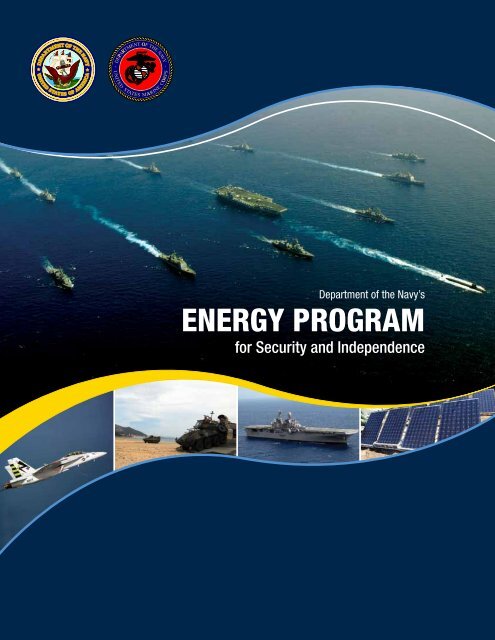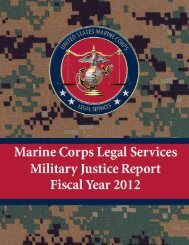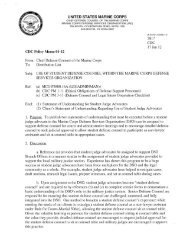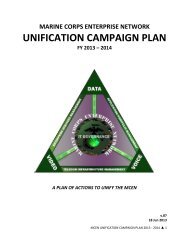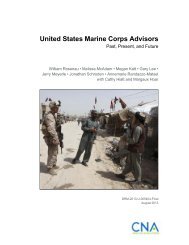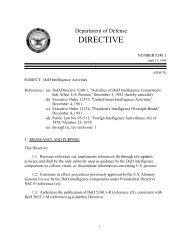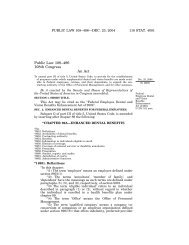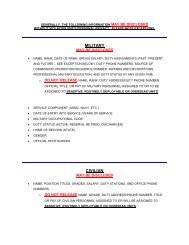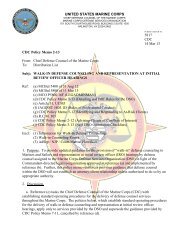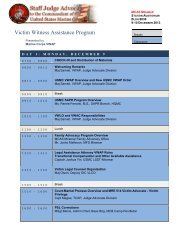Naval Energy Strategic Roadmap - US Department of the Navy ...
Naval Energy Strategic Roadmap - US Department of the Navy ...
Naval Energy Strategic Roadmap - US Department of the Navy ...
You also want an ePaper? Increase the reach of your titles
YUMPU automatically turns print PDFs into web optimized ePapers that Google loves.
<strong>Department</strong> <strong>of</strong> <strong>the</strong> <strong>Navy</strong>’s<br />
ENERGY PROGRAM<br />
for Security and Independence
Table <strong>of</strong> Contents<br />
<strong>Naval</strong> <strong>Energy</strong> Vision, Priorities, and Goals......................................................................................................................................... 2<br />
<strong>Naval</strong> <strong>Energy</strong> Vision..................................................................................................................................................... 2<br />
<strong>Naval</strong> <strong>Energy</strong> Priorities for <strong>Energy</strong> Reform.............................................................................................................. 2<br />
Secretary <strong>of</strong> <strong>the</strong> <strong>Navy</strong>’s <strong>Energy</strong> Goals...................................................................................................................... 3<br />
Current State <strong>of</strong> <strong>Energy</strong> Utilization Across <strong>Department</strong> <strong>of</strong> <strong>the</strong> <strong>Navy</strong> ................................................................. 4<br />
Where <strong>Department</strong> <strong>of</strong> <strong>the</strong> <strong>Navy</strong> Is Now............................................................................................................................................... 4<br />
<strong>Naval</strong> Progress in Reducing <strong>Energy</strong> Consumption ................................................................................................ 6<br />
Utilization <strong>of</strong> Alternative <strong>Energy</strong> Sources................................................................................................................ 7<br />
DON Tactical and Shore <strong>Energy</strong> Initiatives.............................................................................................................. 7<br />
Shore and Tactical <strong>Energy</strong> Mandates.................................................................................................................................................. 9<br />
Setting <strong>Department</strong> <strong>of</strong> <strong>the</strong> <strong>Navy</strong>’s <strong>Energy</strong> Course............................................................................................................................ 10<br />
<strong>Strategic</strong> Program Elements.................................................................................................................................... 11<br />
<strong>Energy</strong> Efficient Acquisition..................................................................................................................................... 12<br />
<strong>Energy</strong> Management ................................................................................................................................................ 12<br />
Governance.......................................................................................................................................................... 12<br />
Planning, Programming, and Budgeting.............................................................................................................. 14<br />
Science and Technology........................................................................................................................................... 14<br />
Maritime Technology Development.................................................................................................................... 15<br />
Aviation Technology Development...................................................................................................................... 15<br />
Expeditionary Technology Development............................................................................................................. 15<br />
Shore Technology Development.......................................................................................................................... 15<br />
Alternative Fuel Certification............................................................................................................................... 16<br />
Behavioral Change.................................................................................................................................................... 16<br />
Education and Training........................................................................................................................................ 16<br />
Awards and Incentives........................................................................................................................................ 16<br />
<strong>Strategic</strong> Partnerships.............................................................................................................................................. 17<br />
Federal Agencies................................................................................................................................................. 17<br />
State <strong>Energy</strong> Offices............................................................................................................................................ 17<br />
Regional <strong>Energy</strong> and Non-Governmental Organizations..................................................................................... 17<br />
Utility Service Providers...................................................................................................................................... 17<br />
Industry and Trade Associations ........................................................................................................................ 18<br />
Universities and Technical Centers <strong>of</strong> Excellence............................................................................................... 18<br />
Challenges............................................................................................................................................................................................... 19<br />
Technology Maturity.................................................................................................................................................. 19<br />
Resource Availability................................................................................................................................................. 19<br />
Alternative Fuel Availability...................................................................................................................................... 19<br />
Business Process Transformation ......................................................................................................................... 20<br />
Data Management..................................................................................................................................................... 20<br />
Moving Forward..................................................................................................................................................................................... 21<br />
Appendices............................................................................................................................................................................................. 23<br />
<strong>Department</strong> <strong>of</strong> <strong>the</strong> <strong>Navy</strong>’s <strong>Energy</strong> Program for Security and Independence<br />
1
<strong>Naval</strong> <strong>Energy</strong><br />
Vision, Priorities, and Goals<br />
naval energy vision<br />
The <strong>Navy</strong> and Marine Corps will lead <strong>the</strong> <strong>Department</strong> <strong>of</strong> Defense (DoD) and <strong>the</strong><br />
nation in bringing about improved energy security, energy independence, and a new<br />
energy economy.<br />
The Secretary <strong>of</strong> <strong>the</strong> <strong>Navy</strong> (SECNAV) has set forth<br />
five energy goals to reduce <strong>Department</strong> <strong>of</strong> <strong>the</strong> <strong>Navy</strong>’s<br />
(DON’s) overall consumption <strong>of</strong> energy, decrease its<br />
reliance on petroleum, and significantly increase its use<br />
<strong>of</strong> alternative energy. Meeting <strong>the</strong>se goals requires that<br />
<strong>the</strong> <strong>Navy</strong> and Marine Corps value energy as a critical<br />
resource across maritime, aviation, expeditionary, and<br />
shore missions. DON’s <strong>Energy</strong> Program for Security<br />
and Independence will lead <strong>the</strong> <strong>Navy</strong> and Marine<br />
Corps efforts to improve operational effectiveness<br />
while increasing energy security and advancing energy<br />
independence. DON will achieve <strong>the</strong> SECNAV goals<br />
by adopting energy efficient acquisition practices,<br />
technologies, and operations.<br />
<strong>Naval</strong> <strong>Energy</strong> Priorities for <strong>Energy</strong> Reform<br />
SECNAV has set two priorities for <strong>Naval</strong> energy reform:<br />
<strong>Energy</strong> Security and <strong>Energy</strong> Independence.<br />
ff<br />
<strong>Energy</strong> Security is achieved by utilizing sustainable<br />
sources that meet tactical, expeditionary, and shore<br />
operational requirements and force sustainment<br />
functions, and having <strong>the</strong> ability to protect and<br />
deliver sufficient energy to meet operational needs.<br />
ff<br />
<strong>Energy</strong> Independence is achieved when <strong>Naval</strong> forces<br />
rely only on energy resources that are not subject to<br />
intentional or accidental supply disruptions. As a<br />
priority, energy independence increases operational<br />
effectiveness by making <strong>Naval</strong> forces more energy<br />
self-sufficient and less dependent on vulnerable energy<br />
production and supply lines.<br />
2 United States <strong>Department</strong> <strong>of</strong> <strong>the</strong> <strong>Navy</strong>
<strong>Naval</strong> <strong>Energy</strong> Vision, Priorities, and Goals<br />
Figure 1 The Secretary <strong>of</strong> <strong>the</strong> <strong>Navy</strong>’s <strong>Energy</strong> Goals<br />
1. <strong>Energy</strong> Efficient Acquisition<br />
Evaluation <strong>of</strong> energy factors will be mandatory when awarding contracts<br />
for systems and buildings.<br />
2. Sail <strong>the</strong> “Great Green Fleet”<br />
DON will demonstrate a Green Strike Group in local operations by 2012<br />
and sail it by 2016.<br />
3. Reduce Non-Tactical<br />
Petroleum Use<br />
By 2015, DON will reduce petroleum use in <strong>the</strong> commercial vehicle<br />
fleet by 50%.<br />
4. Increase Alternative<br />
<strong>Energy</strong> Ashore<br />
By 2020, DON will produce at least 50% <strong>of</strong> shore based energy requirements<br />
from alternative sources; 50% <strong>of</strong> DON installations will be net-zero.<br />
5. Increase Alternative <strong>Energy</strong><br />
Use DON-Wide<br />
By 2020, 50% <strong>of</strong> total DON energy consumption will come<br />
from alternative sources.<br />
DON will increase its energy security and pursue<br />
energy independence by increasing its use <strong>of</strong> alternative<br />
energy, including bi<strong>of</strong>uels, solar, wind, hydro,<br />
geo<strong>the</strong>rmal, and nuclear; and aggressively pursuing<br />
conservation, energy efficient technologies, and energy<br />
supply management innovations.<br />
Secretary <strong>of</strong> <strong>the</strong> <strong>Navy</strong>’s <strong>Energy</strong> Goals<br />
The President <strong>of</strong> <strong>the</strong> United States set forth a bold energy<br />
agenda that seeks to reduce <strong>the</strong> nation’s dependence on<br />
fossil fuels, address <strong>the</strong> threat <strong>of</strong> global climate change,<br />
and create green jobs. At <strong>the</strong> same time, DON is<br />
subject to statutory mandates, executive orders, strategic<br />
guidance and DoD policy that regulate shore and tactical<br />
energy usage.<br />
In support <strong>of</strong> <strong>the</strong> President’s energy agenda, SECNAV<br />
committed <strong>the</strong> <strong>Navy</strong> and Marine Corps to meeting<br />
five energy goals listed in Figure 1. 1 These goals provide<br />
direction to <strong>the</strong> <strong>Navy</strong> and Marine Corps for achieving<br />
energy security and independence.<br />
fig1_06<br />
PATUXENT RIVER, MD (April 22, 2010) Secretary <strong>of</strong><br />
<strong>the</strong> <strong>Navy</strong> (SECNAV) <strong>the</strong> Honorable Ray Mabus greets <strong>Navy</strong><br />
pilots Lt. John Kollar and Lt. Cmdr. Tom Weaver following a<br />
showcase <strong>of</strong> a supersonic flight test <strong>of</strong> <strong>the</strong> “Green Hornet,”<br />
conducted at <strong>Naval</strong> Air Station Patuxent River, MD. The F/A-18<br />
Super Hornet strike fighter jet is powered by a 50/50 bi<strong>of</strong>uel<br />
blend. The SECNAV has made research, development, and<br />
increased use <strong>of</strong> alternative fuels a priority for <strong>Department</strong> <strong>of</strong><br />
<strong>the</strong> <strong>Navy</strong>. (U.S. <strong>Navy</strong> photo by Mass Communication Specialist<br />
2nd Class Kevin S. O’Brien)<br />
1 Based on remarks from Secretary <strong>of</strong> <strong>the</strong> <strong>Navy</strong>’s <strong>Energy</strong> Message to <strong>the</strong> Fleet,<br />
October 2009.<br />
<strong>Department</strong> <strong>of</strong> <strong>the</strong> <strong>Navy</strong>’s <strong>Energy</strong> Program for Security and Independence<br />
3
Where <strong>Department</strong> <strong>of</strong><br />
<strong>the</strong> <strong>Navy</strong> Is Now<br />
<strong>Naval</strong> forces need energy to fuel tactical, expeditionary, and shore operations. Knowing<br />
how and where <strong>Navy</strong> and Marine Corps use energy today, establishes a baseline for<br />
measuring progress against <strong>the</strong> SECNAV goals, federal statutes, executive orders, and<br />
DoD policy.<br />
Current State <strong>of</strong> <strong>Energy</strong> Utilization<br />
Across <strong>Department</strong> <strong>of</strong> <strong>the</strong> <strong>Navy</strong><br />
The SECNAV goals set forth an aggressive target<br />
to supply 50 percent <strong>of</strong> DON energy demand with<br />
alternative sources, such as solar, wind, bi<strong>of</strong>uels,<br />
and geo<strong>the</strong>rmal energy by 2020. Figure 2 shows <strong>the</strong><br />
breakdown <strong>of</strong> both shore and tactical <strong>Naval</strong> energy<br />
consumption by fuel source. Petroleum fuels are<br />
<strong>the</strong> primary energy source at 57 percent, followed<br />
by electricity, natural gas, and o<strong>the</strong>r sources 2 which<br />
account for 26 percent, and nuclear energy representing<br />
16 percent. Renewable sources currently account for<br />
approximately 1 percent <strong>of</strong> overall DON energy sources.<br />
Figure 2 <strong>Naval</strong> <strong>Energy</strong> Consumption by Fuel Source<br />
(Shore and Tactical Combined), FY 2008 1<br />
Nuclear<br />
16%<br />
Electricity/Natural<br />
Gas/O<strong>the</strong>r<br />
26%<br />
Renewables<br />
1%<br />
Petroleum<br />
57%<br />
fig2_05<br />
2 O<strong>the</strong>r sources include liquefied petroleum gas, propane, purchased steam, fuel oil,<br />
and coal.<br />
3 Source: <strong>Navy</strong> <strong>Energy</strong> Coordination Office<br />
4 United States <strong>Department</strong> <strong>of</strong> <strong>the</strong> <strong>Navy</strong>
Where <strong>Department</strong> <strong>of</strong> <strong>the</strong> <strong>Navy</strong> Is Now<br />
Figure 3 <strong>Naval</strong> Petroleum Consumption—National and <strong>Department</strong> <strong>of</strong> Defense Context, FY 2008<br />
United States Federal Government <strong>Department</strong> <strong>of</strong> Defense<br />
Federal Government<br />
2%<br />
O<strong>the</strong>r Federal<br />
Government 7%<br />
Army<br />
9%<br />
Civilian<br />
98%<br />
DoD<br />
93%<br />
<strong>US</strong>AF<br />
57%<br />
DON<br />
34%<br />
Figure 4 <strong>Naval</strong> Petroleum Consumption Pr<strong>of</strong>ile, FY 2008<br />
fig3_05<br />
DON <strong>Navy</strong> Marine Corps<br />
Expeditionary<br />
16%<br />
Shore 6%<br />
Expeditionary<br />
1%<br />
Shore 6%<br />
Shore 5%<br />
Aviation<br />
40%<br />
Maritime<br />
38%<br />
Aviation<br />
42%<br />
Maritime<br />
51%<br />
Aviation<br />
34%<br />
Expeditionary<br />
61%<br />
Three SECNAV goals focus on reducing <strong>Naval</strong><br />
petroleum consumption:<br />
ff<br />
Increase Alternative <strong>Energy</strong> Use <strong>Department</strong>wide:<br />
By 2020, 50 percent <strong>of</strong> DON total energy<br />
consumption, ashore and afloat, will come from<br />
alternative sources<br />
ff<br />
Sail <strong>the</strong> “Great Green Fleet”: By 2016, <strong>the</strong> <strong>Navy</strong><br />
will sail <strong>the</strong> Great Green Fleet, a carrier strike group<br />
composed <strong>of</strong> nuclear ships, hybrid electric ships<br />
running on bi<strong>of</strong>uel, and aircraft flying on bi<strong>of</strong>uel<br />
ff<br />
Reduce Non-Tactical Petroleum Use: By 2015,<br />
DON will cut in half <strong>the</strong> amount <strong>of</strong> petroleum used<br />
in <strong>the</strong> commercial vehicle fleet through <strong>the</strong> phased<br />
adoption <strong>of</strong> hybrid, electric, and flex fuel vehicles<br />
fig4_06<br />
The United States consumes approximately 7.1 billion<br />
barrels <strong>of</strong> petroleum per year, or 25 percent <strong>of</strong> total<br />
world petroleum consumption. The DoD is by far <strong>the</strong><br />
largest federal consumer, accounting for 93 percent<br />
<strong>of</strong> <strong>the</strong> total U.S. Federal Government petroleum use.<br />
Within DoD, DON accounts for 34 percent <strong>of</strong> total<br />
petroleum consumption, as compared to <strong>the</strong> Air Force<br />
(57 percent) and Army (9 percent). Figure 3 shows <strong>Naval</strong><br />
petroleum consumption within <strong>the</strong> context <strong>of</strong> United<br />
States, DoD, and <strong>the</strong> U.S. Armed Forces.<br />
Figure 4 shows DON, <strong>Navy</strong>, and Marine Corps petroleum<br />
consumption across maritime, aviation, expeditionary,<br />
and shore domains. Overall, maritime and aviation energy<br />
usage comprise 78 percent <strong>of</strong> <strong>Naval</strong> petroleum demand.<br />
Expeditionary operations account for approximately 16<br />
percent, and shore operations 6 percent.<br />
<strong>Department</strong> <strong>of</strong> <strong>the</strong> <strong>Navy</strong>’s <strong>Energy</strong> Program for Security and Independence<br />
5
Where <strong>Department</strong> <strong>of</strong> <strong>the</strong> <strong>Navy</strong> Is Now<br />
Figure 5 <strong>Naval</strong> Facility <strong>Energy</strong> Intensity Reduction Trend<br />
Percentage<br />
0<br />
Percentage<br />
0<br />
-5<br />
-5<br />
-10<br />
-10<br />
-15<br />
-15<br />
-20<br />
-20<br />
-25<br />
Reduction Goal (BTUs/GSF)<br />
Actual DON Reduction<br />
Projected DON Reduction<br />
-25<br />
-30<br />
FY<br />
2004<br />
FY<br />
2005<br />
FY<br />
2006<br />
FY<br />
2007<br />
FY<br />
2008<br />
FY<br />
2009<br />
FY<br />
2010<br />
-30<br />
FY<br />
2011<br />
<strong>Naval</strong> Progress in Reducing<br />
<strong>Energy</strong> Consumption<br />
<strong>Energy</strong> management is not new to <strong>the</strong> <strong>Navy</strong> and Marine<br />
Corps. Existing statutes and executive orders require<br />
reductions in facility energy intensity and greenhouse<br />
gas emissions while expanding <strong>the</strong> use <strong>of</strong> renewable and<br />
alternative sources <strong>of</strong> energy. Recent legislation and DoD<br />
policy set new requirements for managing operational<br />
energy. The SECNAV goals set forth an aggressive path<br />
that will put <strong>the</strong> <strong>Navy</strong> and Marine Corps out in front <strong>of</strong><br />
<strong>the</strong>se mandates.<br />
DON’s progress towards meeting <strong>the</strong> facility energy<br />
intensity reduction goals can be seen in Figure 5. Facility<br />
energy intensity is down 30 percent from 1985 and<br />
14 percent from <strong>the</strong> 2003 baseline. The <strong>Naval</strong> <strong>Energy</strong><br />
Program will build on this progress with renewed focus on<br />
energy efficiency in shore facilities.<br />
fig6_04<br />
NAVAL STATION GUANTANAMO BAY, CUBA (Mar. 29, 2005)<br />
At 80 meters (262 feet) high, <strong>the</strong> three-blade wind turbines are<br />
among <strong>the</strong> most noticeable features at <strong>Naval</strong> Station Guantanamo<br />
Bay, Cuba. (U.S. <strong>Navy</strong> photo by Kathleen T. Rhem)<br />
6 United States <strong>Department</strong> <strong>of</strong> <strong>the</strong> <strong>Navy</strong>
Where <strong>Department</strong> <strong>of</strong> <strong>the</strong> <strong>Navy</strong> Is Now<br />
Utilization <strong>of</strong> Alternative <strong>Energy</strong> Sources<br />
Two <strong>of</strong> <strong>the</strong> SECNAV goals require adoption <strong>of</strong><br />
alternative energy sources at shore facilities. In FY 2009,<br />
DON generated and consumed nearly 15,400 megawatt<br />
hours (MWh) <strong>of</strong> renewable electricity and 675,000<br />
MMBtu <strong>of</strong> renewable <strong>the</strong>rmal energy. Including all<br />
renewable energy sources (electric and <strong>the</strong>rmal), 3.2<br />
percent <strong>of</strong> <strong>Naval</strong> shore electrical energy consumption is<br />
sourced from renewable solutions. 3<br />
Don tactical and shore energy initiatives<br />
DON has undertaken many initiatives to improve energy<br />
efficiency, reduce overall energy usage, and harness<br />
alternative fuels and renewable energy sources. Hybrid<br />
electric drives and o<strong>the</strong>r technologies provide options<br />
for increased energy efficiency in current and future<br />
platforms. Migrating appropriate training to advanced<br />
aviation simulators reduces <strong>Naval</strong> aviation petroleum<br />
consumption, and specific aviation operational practices<br />
influence fuel burn rates. The Marine Corps is reducing<br />
<strong>the</strong> logistics burden associated with providing power<br />
to remote locations by utilizing solar-powered battery<br />
systems, which additionally have <strong>the</strong> potential to reduce<br />
fuel used to power generators. Expeditionary energy<br />
usage presents a unique set <strong>of</strong> challenges, which <strong>the</strong><br />
Marine Corps’ Expeditionary <strong>Energy</strong> Office (E2O) is<br />
aggressively working to solve. DON continues to explore<br />
how to integrate practical improvements to optimize<br />
efficiencies in operations.<br />
Examples <strong>of</strong> some <strong>of</strong> <strong>the</strong> high-level near- and long-term<br />
actions that are ei<strong>the</strong>r underway or planned by DON are<br />
shown in Table 1.<br />
Marine Corps Air Ground Combat Center Twentynine<br />
Palms (U.S. Marine Corps Photo, Jun 14, 2010)<br />
4 This electrical energy consumption number (<strong>of</strong> 3.2 percent) does not include<br />
<strong>the</strong> renewable production from <strong>the</strong> geo<strong>the</strong>rmal power plant located at <strong>Naval</strong> Air<br />
Weapons Station China Lake, which produces 270 megawatts (MW) <strong>of</strong> generation<br />
capacity but is not directly consumed by <strong>Naval</strong> shore operations.<br />
<strong>Department</strong> <strong>of</strong> <strong>the</strong> <strong>Navy</strong>’s <strong>Energy</strong> Program for Security and Independence<br />
7
Where <strong>Department</strong> <strong>of</strong> <strong>the</strong> <strong>Navy</strong> Is Now<br />
Table 1<br />
Recent and Planned <strong>Naval</strong> <strong>Energy</strong> Initiatives<br />
Focus Area Near Term Long Term<br />
Conservation<br />
and Efficiency<br />
ffModify platforms with proven technology<br />
ffExpand i-ENCON for aircraft<br />
ffInstitute measurement and verification<br />
systems and protocol<br />
ffAdopt operating practices that reduce<br />
energy usage<br />
ffAdopt alternative prime mover technologies<br />
and hull designs<br />
ffCodify operating practices and train<br />
operators continuously<br />
ffIncreased simulator usage<br />
Tactical<br />
ffConduct shipboard energy audits<br />
ffCertify aircraft and ship systems to operate<br />
on a 50/50 alternative fuel blend<br />
ffIntegrate alternative fuels and concepts into<br />
new systems designs<br />
Alternatives<br />
ffAdopt commercial power solutions where<br />
feasible<br />
ffDemonstrate emerging technologies at<br />
<strong>US</strong>MC Experimental Forward Operating Base<br />
ffPursue Science & Technology (S&T)<br />
investments for cutting-edge technologies<br />
ffExpand <strong>the</strong> usage <strong>of</strong> Ground Renewable<br />
Expeditionary <strong>Energy</strong> Systems (GREENS) in<br />
<strong>the</strong> battlefield<br />
Shore<br />
Conservation<br />
and Efficiency<br />
ffConduct facility energy audits<br />
ffAdopt advanced metering and integrate with<br />
energy management systems<br />
ffPursue building recommissioning<br />
ffRequire at least LEED Silver certification for<br />
new construction and major renovations<br />
ffIntegrate Smart Grid enhancements<br />
ffPursue Research, Development, Test and<br />
Evaluation (RDTE) on innovative energy<br />
technologies<br />
ffDemonstrate and adopt innovative facility<br />
technologies<br />
ffWork with industry to develop cutting-edge<br />
technologies<br />
ffDevelop necessary alternative fuel<br />
infrastructure<br />
ffConduct RDTE on renewable power<br />
generating technologies<br />
Alternatives<br />
ffAggressively adopt commercial solutions<br />
ffInstall wind, solar, biomass and explore<br />
geo<strong>the</strong>rmal<br />
ffConduct RDTE on next generation bi<strong>of</strong>uels<br />
ffRapidly deploy alternative-fueled vehicles<br />
8 United States <strong>Department</strong> <strong>of</strong> <strong>the</strong> <strong>Navy</strong>
Shore and Tactical<br />
<strong>Energy</strong> Mandates<br />
Recent legislation and executive orders have expanded mandatory energy reduction<br />
goals, broadening <strong>the</strong> focus from demand-side efficiencies to supply-side alternative and<br />
renewable energy development.<br />
The SECNAV energy goals set <strong>the</strong> <strong>Navy</strong> and Marine<br />
Corps on a course to exceed <strong>the</strong>se mandates and to lead<br />
DoD and <strong>the</strong> nation in adopting alternative energy<br />
sources and advanced energy efficient technologies.<br />
Appendix A summarizes key legislative and executive<br />
mandates for shore energy.<br />
The need to manage operational energy demand from<br />
tactical and expeditionary systems is likewise recognized in<br />
recent legislation, high-level planning guidance, and DoD<br />
policy as highlighted in Appendix B. SECNAV’s priorities<br />
<strong>of</strong> <strong>Energy</strong> Security and Independence align <strong>the</strong> <strong>Navy</strong><br />
and Marine Corps with Congressional and DoD goals <strong>of</strong><br />
reducing <strong>the</strong> operational risks posed by excessive platform<br />
energy demand and vulnerable energy supply lines.<br />
QUANTICO, VA (March 4, 2010) A 300-watt photovoltaic<br />
battery system, developed by <strong>the</strong> Office <strong>of</strong> <strong>Naval</strong> Research,<br />
can provide continuous power to Marines in <strong>the</strong> field.<br />
The solar-powered battery, called <strong>the</strong> Ground Renewable<br />
Expeditionary <strong>Energy</strong> System (GREENS), is designed by<br />
<strong>the</strong> Advanced Power Generation Future <strong>Naval</strong> Capabilities<br />
program located at <strong>the</strong> Experimental Forward Operating<br />
Base at Marine Corps System Command Transportation<br />
Demonstration Support Area in Quantico, VA. (U.S. <strong>Navy</strong> photo<br />
by John F. Williams)<br />
<strong>Department</strong> <strong>of</strong> <strong>the</strong> <strong>Navy</strong>’s <strong>Energy</strong> Program for Security and Independence<br />
9
Setting <strong>Department</strong> <strong>of</strong> <strong>the</strong> <strong>Navy</strong>’s<br />
<strong>Energy</strong> Course<br />
Three major strategies underlie DON’s <strong>Energy</strong> Program for Security and Independence:<br />
increasing <strong>the</strong> energy efficiency <strong>of</strong> tactical and shore systems; increasing <strong>the</strong> use <strong>of</strong><br />
alternative energy; and steadfast environmental stewardship. These strategies contribute<br />
to <strong>the</strong> energy security <strong>of</strong> shore facilities; foster independence from petroleum fuel and its<br />
associated supply tail; and form <strong>the</strong> basis <strong>of</strong> <strong>the</strong> energy program.<br />
1. <strong>Energy</strong> Efficiency. Increased energy efficiency in<br />
maritime, aviation, and expeditionary systems increases<br />
<strong>the</strong> combat effectiveness <strong>of</strong> <strong>Naval</strong> forces by reducing<br />
<strong>the</strong> frequency <strong>of</strong> fuel re-supplies. <strong>Energy</strong> efficient<br />
shore facilities contribute to operational effectiveness<br />
by reducing <strong>the</strong> resources needed to sustain support<br />
operations. DON will develop and deploy new energy<br />
efficient technologies for tactical systems and adopt<br />
comprehensive energy efficient technologies, systems,<br />
and processes for its shore facilities.<br />
SAN DIEGO, CA Solar photovoltaic power systems (SPVPS)<br />
installed at <strong>Naval</strong> Base San Diego (NBSD) are utilized to<br />
generate alternative energy to supply power to <strong>the</strong> base’s<br />
buildings.<br />
2. Alternative <strong>Energy</strong>. Alternative energy is energy<br />
derived from non-petroleum sources. Increasing<br />
<strong>the</strong> use <strong>of</strong> alternative energy reduces our overall<br />
<strong>Naval</strong> dependence on petroleum, and mitigates <strong>the</strong><br />
risks posed by vulnerable energy supplies for shore<br />
facilities. Alternative energy sources include, but are<br />
not limited to, wind, solar, geo<strong>the</strong>rmal, wave energy,<br />
tidal currents, nuclear energy, and bi<strong>of</strong>uels derived<br />
from algae, camelina, and o<strong>the</strong>r feedstocks.<br />
10 United States <strong>Department</strong> <strong>of</strong> <strong>the</strong> <strong>Navy</strong>
Setting <strong>Department</strong> <strong>of</strong> <strong>the</strong> <strong>Navy</strong>’s <strong>Energy</strong> Course<br />
3. Environmental Stewardship. Environmental<br />
stewardship is <strong>the</strong> responsibility <strong>of</strong> all personnel.<br />
DON will reduce greenhouse gas emissions and<br />
o<strong>the</strong>r environmental impacts associated with <strong>Naval</strong><br />
energy consumption by adopting conservation<br />
practices, incorporating sustainability into facility<br />
design, construction, operations and maintenance;<br />
and by actively managing its fuel use in tactical and<br />
expeditionary operations.<br />
<strong>Strategic</strong> Program Elements<br />
<strong>Department</strong> <strong>of</strong> <strong>the</strong> <strong>Navy</strong>’s <strong>Energy</strong> Program for Security<br />
and Independence is comprised <strong>of</strong> five strategic elements<br />
that will drive specific actions towards meeting <strong>the</strong><br />
SECNAV goals. They are:<br />
ff<br />
<strong>Energy</strong> Efficient Acquisition<br />
ff<br />
<strong>Energy</strong> Management<br />
ff<br />
Science and Technology<br />
ff<br />
Behavioral Change<br />
ff<br />
<strong>Strategic</strong> Partnerships<br />
Figure 6 <strong>Naval</strong> <strong>Energy</strong> Governance and Reporting Structure<br />
SECNAV<br />
Office <strong>of</strong> General<br />
Counsel (OGC)<br />
ASN (FM&C)<br />
ASN (EI&E)<br />
ASN (RD&A)<br />
PDASN (EI&E)<br />
ONR<br />
Director, <strong>Energy</strong><br />
and Environmental<br />
Readiness (<strong>US</strong>N)<br />
Director<br />
Expeditionary <strong>Energy</strong><br />
(<strong>US</strong>MC)<br />
DASN (<strong>Energy</strong>)<br />
DASN (Environment)<br />
Core DASN<br />
(<strong>Energy</strong>) Staff<br />
Deputy Director<br />
Advisory Support<br />
CNO Nominated<br />
Flag Officer<br />
Operational <strong>Energy</strong><br />
Policy (<strong>Navy</strong>)<br />
Expeditionary<br />
<strong>Energy</strong> Policy (<strong>US</strong>MC)<br />
Shore <strong>Energy</strong> Policy<br />
(<strong>Navy</strong> & <strong>US</strong>MC)<br />
CMC Nominated<br />
Officer<br />
Coordination<br />
fig6_06<br />
<strong>Department</strong> <strong>of</strong> <strong>the</strong> <strong>Navy</strong>’s <strong>Energy</strong> Program for Security and Independence<br />
11
Setting <strong>Department</strong> <strong>of</strong> <strong>the</strong> <strong>Navy</strong>’s <strong>Energy</strong> Course<br />
<strong>Energy</strong> Efficient Acquisition<br />
SECNAV is committing DON to transforming its<br />
requirements-setting, acquisition, and contracting<br />
processes to incorporate energy efficiency into decisions<br />
for new systems and buildings. DON will make energy<br />
a consideration in new contract awards and consider<br />
<strong>the</strong> overall energy footprint <strong>of</strong> contractors as part <strong>of</strong><br />
<strong>the</strong> acquisition process. For tactical systems, <strong>the</strong> <strong>Navy</strong><br />
and Marine Corps will incorporate <strong>the</strong> fully burdened<br />
cost <strong>of</strong> fuel (FBCF) methodology in determining life<br />
cycle energy costs, and set <strong>the</strong> energy demand <strong>of</strong> new<br />
systems with an operational energy Key Performance<br />
Parameter (eKPP) to optimize operational effectiveness<br />
and limit fuel logistics impacts. For buildings and energy<br />
consuming facilities, <strong>the</strong> life cycle energy costs will be<br />
a mandatory evaluation factor used when awarding<br />
contracts. When purchasing building equipment,<br />
<strong>of</strong>fice products, or any appliance or system, DON<br />
will purchase only products that meet <strong>the</strong> U.S. EPA’s<br />
ENERGY STAR rating or Federal <strong>Energy</strong> Management<br />
Program (FEMP) designated products where available.<br />
DON will incorporate energy performance into <strong>the</strong><br />
Preferred Supplier Program in order to make <strong>the</strong> energy<br />
footprint <strong>of</strong> a competing company an additional factor<br />
in acquisition decisions. These measures will produce<br />
lasting change by encouraging industry to take steps to<br />
produce <strong>Naval</strong> systems, buildings, and equipment in<br />
energy efficient ways.<br />
<strong>Energy</strong> Management<br />
DON has established an energy management structure<br />
across <strong>the</strong> <strong>Naval</strong> enterprise. The structure sets forth<br />
formal governance roles and responsibilities, planning,<br />
programming, and budgeting for energy initiatives and<br />
provides a reporting structure for coordination between<br />
policy and implementing functions within DON.<br />
Governance<br />
The organizational and reporting structure for energy<br />
management established within DON is shown in<br />
Figure 6 and includes major organizations having <strong>Naval</strong><br />
energy responsibilities.<br />
Senior <strong>Naval</strong> <strong>Energy</strong> Official (ASN (EI&E))<br />
The Assistant Secretary <strong>of</strong> <strong>the</strong> <strong>Navy</strong> for <strong>Energy</strong>,<br />
Installations, and Environment (ASN(EI&E)) is <strong>the</strong><br />
senior <strong>Naval</strong> energy <strong>of</strong>ficial, ultimately responsible for<br />
ensuring that DON energy goals and objectives are met.<br />
DASN <strong>Energy</strong><br />
The Deputy Assistant Secretary <strong>of</strong> <strong>the</strong> <strong>Navy</strong> for <strong>Energy</strong><br />
(DASN <strong>Energy</strong>) will lead <strong>the</strong> coordination <strong>of</strong> <strong>the</strong> <strong>Energy</strong><br />
Program for Security and Independence under ASN<br />
(EI&E). DASN <strong>Energy</strong> is responsible for advocating<br />
for funding and resources for <strong>the</strong> necessary <strong>Navy</strong> and<br />
Marine Corps initiatives. DASN <strong>Energy</strong> is also responsible<br />
for developing <strong>Naval</strong> energy policy and guidance, to<br />
ensure that DON is in compliance with all statutory<br />
requirements, executive orders, and DoD Instructions for<br />
energy management. DASN <strong>Energy</strong> also coordinates with<br />
<strong>the</strong> Chief <strong>of</strong> <strong>Naval</strong> Operations and <strong>the</strong> Commandant <strong>of</strong><br />
<strong>the</strong> Marine Corps to assist with planning, programming,<br />
budgeting, and executing programs to achieve SECNAV’s<br />
energy goals. In addition, DASN <strong>Energy</strong> is responsible<br />
for initiating, coordinating, and managing a strategic<br />
communication plan, internally and externally, for DON’s<br />
energy programs.<br />
DASN Environment<br />
The Deputy Assistant Secretary <strong>of</strong> <strong>the</strong> <strong>Navy</strong> for<br />
Environment is responsible for all environmental matters<br />
that involve DON including environmental planning,<br />
natural resources conservation, cultural resources<br />
management, environmental quality, pollution prevention,<br />
and environmental restoration. These responsibilities<br />
include <strong>the</strong> environmental considerations <strong>of</strong> <strong>Naval</strong> shore,<br />
tactical, and expeditionary energy use. DASN Environment<br />
pursues a balanced approach to maintaining strong<br />
environmental stewardship that manages resources in<br />
support <strong>of</strong> <strong>the</strong> <strong>Navy</strong> and Marine Corps mission.<br />
12 United States <strong>Department</strong> <strong>of</strong> <strong>the</strong> <strong>Navy</strong>
Setting <strong>Department</strong> <strong>of</strong> <strong>the</strong> <strong>Navy</strong>’s <strong>Energy</strong> Course<br />
ASN (RD&A)<br />
The Assistant Secretary <strong>of</strong> <strong>the</strong> <strong>Navy</strong> for Research,<br />
Development, and Acquisition (ASN(RD&A)) ensures<br />
that DON RDT&E execution supports <strong>the</strong> energy<br />
goals <strong>of</strong> SECNAV, in coordination with DASN <strong>Energy</strong>.<br />
ASN(RD&A) is also responsible for developing program<br />
implementation guidance for <strong>the</strong> SECNAV’s goals to make<br />
energy an evaluation factor in DON contracts.<br />
to senior leadership on innovative financing tools and<br />
methods available for executing energy efficiency projects.<br />
SAN DIEGO, CA The amphibious assault ship <strong>US</strong>S Makin<br />
Island (LHD 8) pulls into her homeport <strong>of</strong> San Diego. Makin<br />
Island is <strong>the</strong> final amphibious assault ship built in <strong>the</strong><br />
Wasp-class, but <strong>the</strong> first <strong>of</strong> <strong>the</strong> class built with gas turbine<br />
engines and an electric drive. (U.S. <strong>Navy</strong> photo by Mass<br />
Communication Specialist 2nd Class Jon Husman)<br />
PATUXENT RIVER, MD An F404 engine from an F/A-18 runs<br />
on bi<strong>of</strong>uel in a <strong>Naval</strong> Air Systems Command test at <strong>the</strong> Aircraft<br />
Test and Evaluation Facility, Patuxent River, MD. (U.S. <strong>Navy</strong><br />
photo by David Sckrabulis)<br />
Office <strong>of</strong> <strong>Naval</strong> Research (ONR)<br />
The Office <strong>of</strong> <strong>Naval</strong> Research (ONR), under <strong>the</strong><br />
direction <strong>of</strong> <strong>the</strong> Chief <strong>of</strong> <strong>Naval</strong> Research, plans,<br />
implements, executes, and promotes science and<br />
technology (S&T) programs for DON. The roadmap to<br />
support future forces and energy technology investments<br />
by ONR is <strong>the</strong> <strong>Naval</strong> Science and Technology <strong>Strategic</strong><br />
Plan. ONR reports to SECNAV through ASN (RD&A)<br />
and is responsible for developing a portfolio <strong>of</strong> science<br />
and technology investments that equips DON to<br />
meet <strong>the</strong> SECNAV’s goals, CNO Guidance and o<strong>the</strong>r<br />
applicable energy mandates.<br />
ASN (FM&C)<br />
The Assistant Secretary <strong>of</strong> <strong>the</strong> <strong>Navy</strong> for Financial<br />
Management and Comptroller, ASN (FM&C), directs<br />
and manages <strong>the</strong> financial and budget activities required<br />
to successfully meet <strong>the</strong> SECNAV energy goals. ASN<br />
(FM&C) also provides advice and recommendations<br />
<strong>Navy</strong> Office <strong>of</strong> <strong>the</strong> General Counsel (OGC)<br />
The Assistant General Counsel(<strong>Energy</strong> Installations &<br />
Environment) (AGC(EI&E)) is a senior legal advisor to<br />
<strong>the</strong> <strong>Navy</strong> General Office <strong>of</strong> <strong>the</strong> General Counsel (OGC)<br />
and is tasked by <strong>the</strong> General Counsel with providing<br />
legal counsel and support to ASN(EI&E)) and staff on<br />
all matters within <strong>the</strong> EI&E portfolio.<br />
PATUXENT RIVER, MD An F/A-18F Super Hornet strike<br />
fighter, dubbed <strong>the</strong> “Green Hornet,” conducts a supersonic test<br />
flight. The aircraft is fueled with a 50/50 blend <strong>of</strong> bi<strong>of</strong>uel and<br />
conventional fuel. (U.S. <strong>Navy</strong> photo by Liz Goettee)<br />
<strong>Department</strong> <strong>of</strong> <strong>the</strong> <strong>Navy</strong>’s <strong>Energy</strong> Program for Security and Independence<br />
13
Setting <strong>Department</strong> <strong>of</strong> <strong>the</strong> <strong>Navy</strong>’s <strong>Energy</strong> Course<br />
<strong>Navy</strong> <strong>Energy</strong> Coordination Office (NECO)<br />
The <strong>Navy</strong> <strong>Energy</strong> Coordination Office (NECO)<br />
is responsible for supporting energy efficiency,<br />
conservation, and alternative energy investments for<br />
<strong>Navy</strong> tactical (maritime, aviation, and expeditionary)<br />
and shore forces, developing a comprehensive <strong>Navy</strong><br />
energy strategy, and coordinating with <strong>Naval</strong> Systems<br />
Commands to ensure programs are effectively<br />
implemented. NECO resides in <strong>the</strong> CNO’s <strong>Energy</strong> and<br />
Environmental Readiness Division, under <strong>the</strong> Deputy<br />
Chief <strong>of</strong> <strong>Naval</strong> Operations for Fleet Readiness and<br />
Logistics (N4). 4<br />
as <strong>the</strong> Commandant’s principal advisor on expeditionary<br />
energy and resource matters. 5<br />
TAN TAN, MOROCCO Maj. Sean M. Sadlier (left) <strong>of</strong> <strong>the</strong> U.S.<br />
Marine Corps Expeditionary <strong>Energy</strong> Office explains <strong>the</strong> solar<br />
power element <strong>of</strong> <strong>the</strong> Expeditionary Forward Operating Base<br />
concept to Col. Anthony Fernandez during <strong>the</strong> testing phase<br />
<strong>of</strong> this sustainable energy initiative. The ExFOB is designed<br />
primarily for use by small Marine Corps units at forward<br />
operating bases in Afghanistan. Fernandez, a Marine Corps<br />
Reservist with a combined 28 years in <strong>the</strong> Corps, is <strong>the</strong><br />
African Lion 2010 task force commander. (U.S. Marine Corps<br />
photo by Maj. Paul Greenberg)<br />
PORT HUENEME, CA <strong>Navy</strong> Building 850 at <strong>Naval</strong> Base Ventura<br />
County (NBVC) incorporated energy efficient design elements,<br />
including skylights, open ceilings, exposed ventilation system<br />
ductwork, which maximizes <strong>the</strong> use <strong>of</strong> natural ventilation,<br />
and 100 percent daylighting. The building employs energy<br />
saving equipment, including energy efficient lighting and HVAC<br />
systems. Toge<strong>the</strong>r, <strong>the</strong>se features earned <strong>the</strong> building an<br />
outstanding ENERGY STAR® benchmarking score <strong>of</strong> 96.<br />
<strong>US</strong>MC Expeditionary <strong>Energy</strong> Office (E2O)<br />
The <strong>US</strong>MC Expeditionary <strong>Energy</strong> Office (E2O) is<br />
responsible for analyzing, developing, and directing<br />
<strong>the</strong> Marine Corps’ strategy to improve expeditionary<br />
capabilities across all warfighting functions. E2O<br />
identifies and requests resources to man, train, and equip<br />
<strong>the</strong> Marine Corps to meet <strong>the</strong> SECNAV goals, and all<br />
o<strong>the</strong>r energy mandates. E2O reports directly to <strong>the</strong><br />
Assistant Commandant <strong>of</strong> <strong>the</strong> Marine Corps and serves<br />
Planning, Programming, and Budgeting<br />
<strong>Energy</strong> planning, programming, and budgeting occur<br />
at DON level, <strong>the</strong> component level, and <strong>the</strong> installation<br />
level. The overarching goal for DON’s energy planning<br />
is to develop a portfolio <strong>of</strong> projects that enables DON<br />
to meet <strong>the</strong> SECNAV’s energy goals, and comply<br />
with statutory mandates, executive orders, and DoD<br />
policy directives. DON will pursue innovative funding<br />
arrangements and financing mechanisms for energy<br />
projects to <strong>of</strong>fset <strong>the</strong> high capital costs for energy high<br />
capital costs for alternative fuel and emerging energy<br />
technologies.<br />
Science and Technology<br />
Developing and employing advanced technologies<br />
are imperative in order to reach all <strong>of</strong> <strong>the</strong> SECNAV<br />
energy goals. Investments by ONR in energy science<br />
and technology foster partnerships with o<strong>the</strong>r Federal<br />
4 NECO activities are led by a CNO nominated flag <strong>of</strong>ficer titled “Director, <strong>Energy</strong><br />
and Environmental Readiness (<strong>US</strong>N)” in Figure 6.<br />
5 E2O activities are led by a CMC nominated <strong>of</strong>ficer titled “Director, Expeditionary<br />
<strong>Energy</strong> (<strong>US</strong>MC)” in Figure 6.<br />
14 United States <strong>Department</strong> <strong>of</strong> <strong>the</strong> <strong>Navy</strong>
Setting <strong>Department</strong> <strong>of</strong> <strong>the</strong> <strong>Navy</strong>’s <strong>Energy</strong> Course<br />
agencies, universities, and laboratories; promote an<br />
innovative market and advance commercial capabilities<br />
to deliver energy efficiency; harness alternative energy;<br />
and foster environmental stewardship. The driving<br />
tenants for DON energy science and technology are:<br />
ff<br />
Accelerate adoption <strong>of</strong> nascent advanced<br />
technologies, especially for shore applications;<br />
ff<br />
Work with industry to mature and demonstrate new<br />
technologies for <strong>the</strong> near-term; and<br />
ff<br />
Aggressively research disruptive technologies for tactical<br />
applications that present unique <strong>Naval</strong> challenges<br />
Investments in advanced technologies have <strong>the</strong> unique<br />
opportunity to utilize DON installations as test beds to<br />
measure and evaluate pilot studies <strong>of</strong> new systems and<br />
equipment.<br />
Maritime Technology Development<br />
DON began laying <strong>the</strong> foundation for achieving longterm<br />
energy security by investing in <strong>the</strong> maritime<br />
development <strong>of</strong> state-<strong>of</strong>-<strong>the</strong>-art engines, complemented<br />
by enhanced training <strong>of</strong> a more energy-conscious<br />
force. The cornerstone for <strong>Naval</strong> tactical technology<br />
development is demonstrating <strong>the</strong> Great Green Fleet, a<br />
carrier strike group comprised <strong>of</strong> a carrier, one cruiser,<br />
two destroyers, a submarine and aircraft, all operating<br />
on alternative fuels. In o<strong>the</strong>r areas, Hybrid Electric Drive<br />
WASHINGTON, DC A group photo <strong>of</strong> <strong>the</strong> winning commands<br />
in <strong>the</strong> Blue, Gold, and Platinum levels <strong>of</strong> <strong>the</strong> Secretary<br />
<strong>of</strong> <strong>the</strong> <strong>Navy</strong> <strong>Energy</strong> Awards. The SECNAV <strong>Energy</strong> Awards<br />
recognize commands that have made significant strides and<br />
contributions toward a greener, more energy-efficient <strong>Navy</strong>.<br />
(U.S. <strong>Navy</strong> photo by Mass Communication Specialist 2nd Class<br />
Elizabeth Vlahos)<br />
(HED) technology will potentially improve efficiency by<br />
allowing ships to operate at slow speeds without running<br />
<strong>the</strong>ir main engines. Projects such as <strong>the</strong> Incentivized<br />
<strong>Energy</strong> Conservation Program (i-ENCON) and <strong>the</strong><br />
Smart Voyage Planning s<strong>of</strong>tware will allow <strong>the</strong> warfighter<br />
to consider energy in planning and employ innovative<br />
approaches to energy conservation. Looking to <strong>the</strong><br />
future, DON will monitor and invest in next-generation<br />
bi<strong>of</strong>uels and o<strong>the</strong>r long-term solutions.<br />
Aviation Technology Development<br />
DON is pursuing alternative fuels, engine technology,<br />
and training tactics to reduce its use <strong>of</strong> petroleum in<br />
aviation—DON’s biggest end use. In 2010, <strong>the</strong> <strong>Navy</strong>’s<br />
Green Hornet, an F/A-18, was <strong>the</strong> first supersonic jet<br />
to operate on a bi<strong>of</strong>uel blend. Success in developing an<br />
aviation bi<strong>of</strong>uel is crucial to achieving <strong>the</strong> SECNAV’s<br />
goals <strong>of</strong> reducing by half DON’s energy consumption by<br />
2020 and deploying <strong>the</strong> Great Green Fleet by 2016.<br />
DON is also developing improvements to aircraft<br />
engines that reduce fuel consumption and o<strong>the</strong>r<br />
modifications that allow aircraft to fly far<strong>the</strong>r on each<br />
tank <strong>of</strong> fuel. In addition, DON is identifying options for<br />
migrating to advanced simulators where appropriate to<br />
reduce fuel consumption during training.<br />
Expeditionary Technology Development<br />
Cutting-edge tactical approaches to addressing energy<br />
efficiency provide <strong>the</strong> warfighter with enhanced mobility,<br />
effectiveness, and sustainability. <strong>Energy</strong> efficiency reduces<br />
<strong>the</strong> amount <strong>of</strong> fuel that convoys need to support Forward<br />
Operating Bases (FOBs), increases <strong>the</strong> operating radius,<br />
and reduces <strong>the</strong> overall expeditionary energy footprint.<br />
On-Board Vehicle Power provides exportable electric<br />
power generation capacity and can reduce <strong>the</strong> number <strong>of</strong><br />
generators needed on <strong>the</strong> battlefield. O<strong>the</strong>r expeditionary<br />
renewable and self-sustainable energy technologies<br />
that may be appropriate for DON to fur<strong>the</strong>r develop,<br />
demonstrate or adopt to reduce expeditionary energy<br />
consumption include energy-generating backpacks, fuel<br />
cells, light emitting diode (LED) lighting, improved<br />
environmental controls, and portable solar panels.<br />
<strong>Department</strong> <strong>of</strong> <strong>the</strong> <strong>Navy</strong>’s <strong>Energy</strong> Program for Security and Independence<br />
15
Setting <strong>Department</strong> <strong>of</strong> <strong>the</strong> <strong>Navy</strong>’s <strong>Energy</strong> Course<br />
Shore Technology Development<br />
DON has been a leader in developing alternative<br />
energy while providing secure energy to shore facilities.<br />
Technologies such as Ocean Thermal <strong>Energy</strong> Conversion<br />
(OTEC), wind, solar, wave energy, tidal currents, nuclear<br />
energy, biomass and geo<strong>the</strong>rmal power generation will<br />
be aggressively pursued to reach <strong>the</strong> SECNAV goal<br />
<strong>of</strong> producing 50 percent <strong>of</strong> shore-based energy from<br />
alternative sources by 2020. On <strong>the</strong> demand side, DoD<br />
signed a Memorandum <strong>of</strong> Understanding on Federal<br />
Leadership in High Performance and Sustainable<br />
Buildings, which calls for reducing energy demand in<br />
new facilities 30 percent beyond <strong>the</strong> ASHRAE Standard<br />
90.1-2004 threshold, and employing sustainable design<br />
strategies that are life-cycle cost effective. To address<br />
requirements for <strong>the</strong> sustainable design <strong>of</strong> <strong>Navy</strong> and<br />
Marine Corps facilities, NAVFAC adopted <strong>the</strong> U.S.<br />
Green Building Council’s Leadership in <strong>Energy</strong> &<br />
Environmental Design (LEED) Green Building Rating<br />
System. Incorporating LEED Silver design strategies<br />
into new construction <strong>of</strong>fers increased opportunities<br />
for life cycle cost savings, fulfills DON’s obligations<br />
under EPAct 2005, E.O. 13423, and E.O. 13514, and<br />
promotes steadfast environmental stewardship.<br />
Alternative Fuel Certification<br />
The operational use <strong>of</strong> alternative fuels by <strong>the</strong> <strong>Navy</strong><br />
and Marine Corps will be hastened by collaborating<br />
with federal agencies and private industry involved with<br />
research, development, and certification <strong>of</strong> alternative<br />
fuels. Earth Day 2010 marked a significant milestone<br />
for DON, as <strong>the</strong> <strong>Navy</strong> conducted an aviation flight test<br />
<strong>of</strong> a 50/50 bi<strong>of</strong>uel blend in supersonic operations. The<br />
Green Hornet flight is a critical milestone in DON’s<br />
certification efforts, marking <strong>the</strong> beginning <strong>of</strong> efforts<br />
to expand <strong>the</strong> use <strong>of</strong> alternative fuels across <strong>Navy</strong><br />
and Marine Corps tactical systems. The certification<br />
and testing <strong>of</strong> alternative fuels across <strong>Naval</strong> platforms<br />
will demonstrate DON’s commitment to reducing<br />
dependence on fossil fuels and safeguarding <strong>the</strong><br />
environment.<br />
Behavioral Change<br />
Communication and awareness are critical to achieving<br />
<strong>the</strong> SECNAV energy goals. DON will implement<br />
and maintain culture change initiatives, beginning<br />
with education and training, to ensure that energy<br />
management is understood by all personnel to be a<br />
priority in tactical, expeditionary, and shore missions.<br />
By linking <strong>the</strong> importance <strong>of</strong> energy security and energy<br />
efficiency to mission achievement, DON instills all<br />
personnel with an ethos <strong>of</strong> energy excellence. <strong>Energy</strong><br />
awareness campaigns during April’s Earth Day and<br />
October’s <strong>Energy</strong> Awareness Month will be used to<br />
encourage personal actions that show commitment to<br />
energy program goals. Incentive programs enable <strong>the</strong><br />
positive reinforcement <strong>of</strong> energy innovations in <strong>the</strong><br />
market and lead to successful and sustainable energy<br />
project implementation. Metering will be linked to<br />
advanced monitoring and display technologies to provide<br />
feedback to users on <strong>the</strong>ir energy usage, integrating<br />
metering systems with behavioral change initiatives.<br />
<strong>Energy</strong> education and awards programs will maintain<br />
focus on attaining <strong>the</strong> SECNAV energy goals. DON<br />
will also explore new ways to encourage accountability<br />
by linking energy efficient behaviors to <strong>the</strong> performance<br />
assessment and advancement process.<br />
Education and Training<br />
<strong>Energy</strong> management education and training will include<br />
all DON personnel. The goal <strong>of</strong> energy education and<br />
training is to instill a sense <strong>of</strong> personal accountability<br />
which results in sustained behavioral change. DON<br />
will conduct energy awareness training through online<br />
courses, pr<strong>of</strong>essional certifications, trade associations,<br />
industry partners, and online and printed resources<br />
such as handbooks. <strong>Energy</strong> education and training<br />
will be tailored appropriately for personnel involved<br />
in operations, acquisitions, sustainment, and support<br />
functions. Individual actions will be encouraged and<br />
reinforced through strategic communication efforts that<br />
promote awareness through energy saving posters, tips,<br />
fact sheets, newsletters, seminars, energy working groups,<br />
and energy conferences.<br />
16 United States <strong>Department</strong> <strong>of</strong> <strong>the</strong> <strong>Navy</strong>
Setting <strong>Department</strong> <strong>of</strong> <strong>the</strong> <strong>Navy</strong>’s <strong>Energy</strong> Course<br />
Awards and Incentives<br />
Awards and incentives promote best practices in energy<br />
management across <strong>Naval</strong> operations.The two primary<br />
awards and recognition program for DON are <strong>the</strong><br />
Federal <strong>Energy</strong> Management Program (FEMP) <strong>Energy</strong><br />
Awards Program (for Renewable, <strong>Energy</strong> Efficiency,<br />
<strong>Energy</strong> Program Management, Water Conservation,<br />
and Exceptional Service), and <strong>the</strong> annual Presidential<br />
Awards. DON has also established <strong>the</strong> SECNAV<br />
<strong>Energy</strong> and Water Management Awards program to<br />
recognize installation, shipboard, and aviation energy<br />
accomplishments.<br />
<strong>Strategic</strong> Partnerships<br />
DON will continue to cultivate strategic partnerships<br />
with existing and new organizations and leverage partner<br />
resources and capabilities (e.g. innovations, knowledge,<br />
and experience) in constructing and executing its<br />
energy program. The Army, Air Force, and o<strong>the</strong>r DoD<br />
organizations face energy challenges similar to those <strong>of</strong><br />
<strong>the</strong> <strong>Navy</strong> and Marine Corps, and DON will continue<br />
to work with <strong>the</strong>m. Many outside organizations have<br />
developed programs, tools, materials, and o<strong>the</strong>r resources<br />
that can be utilized by DON. Developing <strong>the</strong>se strategic<br />
partnerships with federal agencies, state energy <strong>of</strong>fices,<br />
regional energy and non-governmental organizations,<br />
energy service contractors, and equipment manufacturers<br />
and vendors is essential to <strong>the</strong> overall success <strong>of</strong> DON in<br />
meeting energy mandates and goals.<br />
State <strong>Energy</strong> Offices<br />
DON recognizes <strong>the</strong> important contributions <strong>of</strong>fered<br />
by state energy <strong>of</strong>fices. DON will pursue partnerships<br />
with state energy <strong>of</strong>fices, explore incentives for renewable<br />
energy projects (through third parties), and leverage state<br />
funding for public awareness on energy. The primary<br />
candidates for state partnerships will be states with<br />
Renewable <strong>Energy</strong> Portfolio Standards (RPS), making<br />
third-party renewable energy projects attractive for DON<br />
shore installations.<br />
Regional <strong>Energy</strong> and Non-Governmental<br />
Organizations<br />
Many regional energy and non-governmental<br />
organizations promote energy efficiency, energy awareness,<br />
and energy program management. DON will reach<br />
out to <strong>the</strong>se organizations to learn and exchange energy<br />
awareness information, best practices, and o<strong>the</strong>r resources.<br />
Utility Service Providers<br />
Utilities have access to public benefit program funding<br />
and <strong>of</strong>ten spend discretionary funds to promote renewable<br />
energy and energy efficiency projects. DON will pursue<br />
utility programs and partner with energy providers<br />
to leverage resources, funding, knowledge, and access<br />
innovative financing options. DON will also aggressively<br />
pursue load-shedding and demand response programs that<br />
promote energy conservation, distributed generation, and<br />
result in financial benefits to shore installations.<br />
Federal Agencies<br />
Federal agencies outside <strong>of</strong> DoD are funding development<br />
<strong>of</strong> alternative energy resources and energy efficiency<br />
innovations, as well as supporting programs intended<br />
to raise <strong>the</strong> awareness <strong>of</strong> energy conservation practices.<br />
Agencies that DON is currently partnering with include:<br />
ff<br />
<strong>Department</strong> <strong>of</strong> <strong>Energy</strong> (DOE)—Working<br />
Groups include Smart Grid, Renewable <strong>Energy</strong>,<br />
Acquisitions, and <strong>Energy</strong> Efficiency.<br />
ff<br />
U.S. <strong>Department</strong> <strong>of</strong> Agriculture (<strong>US</strong>DA)—DON<br />
Memorandum <strong>of</strong> Understanding signed in January<br />
2010 to encourage <strong>the</strong> development <strong>of</strong> advanced<br />
bi<strong>of</strong>uels and o<strong>the</strong>r renewable energy systems.<br />
<strong>Department</strong> <strong>of</strong> <strong>the</strong> <strong>Navy</strong>’s <strong>Energy</strong> Program for Security and Independence<br />
17
Setting <strong>Department</strong> <strong>of</strong> <strong>the</strong> <strong>Navy</strong>’s <strong>Energy</strong> Course<br />
Industry and Trade Associations<br />
DON will need to rely on its industry suppliers for<br />
innovation and cooperation in meeting <strong>the</strong> SECNAV<br />
energy goals. Because <strong>of</strong> <strong>the</strong> expanse <strong>of</strong> <strong>Naval</strong> operations,<br />
<strong>the</strong> types <strong>of</strong> industry involved with this effort span<br />
virtually <strong>the</strong> entire manufacturing and service industrial<br />
base, and include:<br />
ff<br />
Ship and aircraft manufacturing and repair<br />
ff<br />
IT, communications, and electronics manufacturers<br />
ff<br />
Vehicle manufacturers<br />
ff<br />
Fuel developers and suppliers<br />
ff<br />
Builders and construction firms<br />
ff<br />
<strong>Energy</strong> service contractors<br />
ff<br />
Equipment manufacturers and vendors<br />
DON will actively reach out to industry and trade<br />
associations, engineering societies, and o<strong>the</strong>r industry,<br />
trade and pr<strong>of</strong>essional associations to contribute<br />
innovative solutions to <strong>Naval</strong> energy challenges. In<br />
addition, DON will continue to advance solutions<br />
stemming from Small Business Innovative Research<br />
to ensure emerging technologies are incorporated into<br />
DON energy management program.<br />
Universities and Technical Centers <strong>of</strong> Excellence<br />
Much <strong>of</strong> <strong>the</strong> innovation that will be required to achieve<br />
<strong>the</strong> SECNAV’s energy goals is currently being researched<br />
at public and private universities. DON will actively<br />
monitor university publications and technical conferences,<br />
and will rely on ASN (RD&A) and ONR to identify and<br />
recommend promising developments from <strong>the</strong> university<br />
sector. DON will continue to partner with universities to<br />
ensure cutting-edge research and emerging technologies are<br />
integrated into <strong>the</strong> <strong>Naval</strong> energy program.<br />
18 United States <strong>Department</strong> <strong>of</strong> <strong>the</strong> <strong>Navy</strong>
Challenges<br />
Achieving <strong>the</strong> SECNAV’s ambitious energy goals presents challenges for <strong>the</strong> <strong>Navy</strong> and Marine<br />
Corps. Success depends on advancements within five broad categories: technology maturity,<br />
resource availability, alternative fuel availability, business process transformation, and<br />
data management.<br />
TECHNOLOGY MATURITY<br />
Technology continues to mature and <strong>the</strong> ability <strong>of</strong> DON<br />
to leverage leading-edge technology and deploy it in<br />
tactical and shore arenas is critical. DON must be able<br />
to evaluate new systems and make <strong>the</strong> right decisions on<br />
which technologies to invest in while fully understanding<br />
<strong>the</strong> risks associated with using new approaches.<br />
DON will continue to work with industry and o<strong>the</strong>r<br />
partners to build additional market pull to incentivize<br />
investments in alternative technologies, energy sources,<br />
fuels, and infrastructure.<br />
RESOURCE AVAILABILITY<br />
Meeting <strong>the</strong> SECNAV’s goals will require making<br />
difficult decisions to prioritize investments. In <strong>the</strong><br />
current budget environment, DON has an opportunity<br />
develop solutions that leverage <strong>the</strong> financial resources <strong>of</strong><br />
its government and industry partners. DON will need to<br />
work closely with its partners, exploring all appropriate<br />
avenues to fund <strong>the</strong> investments necessary to meet <strong>the</strong><br />
SECNAV’s goals.<br />
DON will also develop its human capital resources and<br />
invest wisely in cultivating skills that deliver energy<br />
excellence. This includes identifying <strong>the</strong> necessary<br />
competencies to manage energy across DON and train<br />
staff in <strong>the</strong> energy disciplines.<br />
ALTERNATIVE FUEL AVAILABILITY<br />
Although <strong>Naval</strong> forces consume millions <strong>of</strong> barrels <strong>of</strong><br />
petroleum products each year, DON is not a major<br />
market driver and <strong>the</strong>refore will need to partner with<br />
<strong>the</strong> commercial marketplace to grow a market where<br />
alternative fuel is available in sufficient quantities. Major<br />
players need to invest in alternative fuel production and<br />
infrastructure technologies—<strong>the</strong> demand for <strong>the</strong>se fuels<br />
must come from <strong>the</strong> commercial marketplace as well<br />
as DON in order to spur investments and drive down<br />
costs. Moreover, <strong>Naval</strong> alternative fuels must be “drop<br />
in” replacements, able to mix with traditional petroleum<br />
<strong>Department</strong> <strong>of</strong> <strong>the</strong> <strong>Navy</strong>’s <strong>Energy</strong> Program for Security and Independence<br />
19
Challenges<br />
products with no adverse effects to <strong>the</strong> fuel quality or<br />
performance. DON will continue to test and certify<br />
equipment for compatibilities with alternative fuels<br />
derived from multiple feedstocks, ensure that alternative<br />
fuels utilized have lower lifecycle greenhouse gas emissions<br />
than conventional petroleum-based fuels, collaborate with<br />
industry and government partners to encourage market<br />
participation, and increase <strong>the</strong> amount <strong>of</strong> alternative fuel<br />
available to <strong>the</strong> commercial and DON markets.<br />
B<strong>US</strong>INESS PROCESS TRANSFORMATION<br />
DON will need to change many <strong>of</strong> its current business<br />
processes to enable transformation to meet its energy<br />
goals. This will include changing acquisition and<br />
contracting practices, operational methodologies,<br />
training routines, and installation energy management<br />
practices. Doctrine, policy, and clarifying guidance will<br />
be necessary to institutionalize behavioral change among<br />
every Sailor, Marine, and DON civilian employee.<br />
DATA MANAGEMENT<br />
Data management is a critical element <strong>of</strong> transformation—<br />
DON needs to measure and monitor its energy usage,<br />
quantify its associated greenhouse gas emissions, and<br />
integrate this information with management dashboards<br />
and personnel awareness initiatives to inform end-users,<br />
managers, and decision-makers.<br />
Bremerton, WA (Jun. 8, 2002) Wayne Weight, a shipyard<br />
worker from Paulsbo, WA, works on revamping <strong>the</strong> JP-5 fueloverflow<br />
system on <strong>the</strong> aircraft carrier <strong>US</strong>S Carl Vinson (CVN<br />
70). Carl Vinson is eliminating 34 <strong>of</strong> its 52 JP-5 fuel-overflow<br />
boxes and installing a more efficient pipe system. The remaining<br />
18 overflow boxes are being replaced following an extensive<br />
deployment in support <strong>of</strong> Operation Enduring Freedom.<br />
(U.S. <strong>Navy</strong> photo by Photographer’s Mate Airman Ryan Jackson)<br />
20 United States <strong>Department</strong> <strong>of</strong> <strong>the</strong> <strong>Navy</strong>
Moving forward<br />
<strong>Department</strong> <strong>of</strong> <strong>the</strong> <strong>Navy</strong>’s <strong>Energy</strong> Program for Security and Independence will drive <strong>the</strong> <strong>Navy</strong><br />
and Marine Corps towards achievement <strong>of</strong> <strong>the</strong> SECNAV’s energy goals while complying with<br />
legislative mandates and executive orders.<br />
The SECNAV goals establish a commitment by <strong>the</strong><br />
DON to significantly reduce energy usage and increase<br />
its use <strong>of</strong> alternative energy, in tactical, shore, and<br />
expeditionary operations, by:<br />
ff<br />
Including energy as an evaluation factor when<br />
awarding new contracts for systems and buildings;<br />
ff<br />
Demonstrating a Green Strike Group in local<br />
operations by 2012, and sailing it by 2016;<br />
ff<br />
Reducing petroleum use in its commercial vehicle<br />
fleet by 50 percent by 2015;<br />
ff<br />
Deriving at least 50 percent <strong>of</strong> its shore energy<br />
requirements from alternative sources, and making<br />
50 percent <strong>of</strong> its installations net-zero by 2020; and<br />
ff<br />
Securing 50 percent <strong>of</strong> total energy demand from<br />
alternative sources by 2020.<br />
Achieving <strong>the</strong>se goals will result in greater energy<br />
security, reduced petroleum fuel dependence, and<br />
mitigation <strong>of</strong> greenhouse gas emissions during <strong>Naval</strong><br />
operations. Moreover, aggressive energy policy and<br />
leadership will improve <strong>the</strong> combat and operational<br />
effectiveness <strong>of</strong> <strong>Naval</strong> forces by reducing <strong>the</strong> risks from<br />
fuel delivery, increasing <strong>the</strong> efficiency <strong>of</strong> tactical systems,<br />
and making <strong>Naval</strong> installations less reliant on vulnerable<br />
ARABIAN SEA (May 20, 2010) The Nimitz-class aircraft carrier<br />
<strong>US</strong>S Dwight D. Eisenhower (CVN 69) and <strong>the</strong> guided-missile<br />
destroyer <strong>US</strong>S Farragut (DDG 99) pull along both sides <strong>of</strong> <strong>the</strong><br />
Military Sealift Command fast combat support ship <strong>US</strong>NS Supply<br />
(T-AOE 6) for a replenishment at sea. Dwight D. Eisenhower and<br />
Farragut are part <strong>of</strong> <strong>the</strong> Eisenhower Carrier Strike Group and<br />
are deployed as part <strong>of</strong> an-ongoing rotation <strong>of</strong> forward-deployed<br />
forces to support maritime security operations in <strong>the</strong> U.S. 5th Fleet<br />
area <strong>of</strong> responsibility. (U.S. <strong>Navy</strong> photo by <strong>Naval</strong> Air Crewman 3rd<br />
Class Ruben N. Coss/Released)<br />
energy supplies. DON will engender an ethos whereby<br />
all personnel are stewards committed to sustainable<br />
energy management practices, and who value <strong>the</strong><br />
efficient use <strong>of</strong> clean and secure energy.<br />
<strong>Department</strong> <strong>of</strong> <strong>the</strong> <strong>Navy</strong>’s <strong>Energy</strong> Program for Security and Independence<br />
21
Appendix A: Shore <strong>Energy</strong> Mandates<br />
Focus Area<br />
Statute/<br />
Executive Order<br />
SECTION Title<br />
Acquisition<br />
<strong>of</strong> Alternative<br />
Fuels and<br />
<strong>Energy</strong> Efficient<br />
Products<br />
Executive Order<br />
13514<br />
October 2009<br />
<strong>Energy</strong><br />
Independence and<br />
Security Act <strong>of</strong> 2007<br />
Provisions<br />
ffAdvance sustainable acquisition to ensure that 95 percent <strong>of</strong> new contract actions<br />
including task and delivery orders, for products and services with <strong>the</strong> exception<br />
<strong>of</strong> acquisition <strong>of</strong> weapon systems, are energy-efficient (<strong>Energy</strong> Star or Federal<br />
<strong>Energy</strong> Management Program (FEMP) designated), water-efficient, biobased,<br />
environmentally preferable (e.g., Electronic Product Environmental Assessment<br />
Tool (EPEAT) certified), non-ozone depleting, contain recycled content, or are nontoxic<br />
or less-toxic alternatives, where such products and services meet agency<br />
performance requirements<br />
ffTo meet <strong>the</strong> requirements <strong>of</strong> an agency for an energy consuming product in a<br />
product category covered by <strong>the</strong> <strong>Energy</strong> Star program or <strong>the</strong> Federal <strong>Energy</strong><br />
Management Program (FEMP) for designated products, <strong>the</strong> head <strong>of</strong> <strong>the</strong> agency<br />
shall procure an <strong>Energy</strong> Star product or a FEMP designated product<br />
ffNo Federal agency shall enter into a contract for procurement <strong>of</strong> an alternative<br />
or syn<strong>the</strong>tic fuel, including a fuel produced from nonconventional petroleum<br />
sources, for any mobility-related use, o<strong>the</strong>r than for research or testing, unless<br />
<strong>the</strong> contract specifies that <strong>the</strong> lifecycle greenhouse gas emissions associated<br />
with <strong>the</strong> production and combustion <strong>of</strong> <strong>the</strong> fuel supplied under <strong>the</strong> contract<br />
must, on an ongoing basis, be less than or equal to such emissions from <strong>the</strong><br />
equivalent conventional fuel produced from conventional petroleum sources<br />
<strong>Energy</strong><br />
Efficiency<br />
and <strong>Energy</strong><br />
Consumption<br />
Executive Order<br />
13514<br />
October 2009<br />
<strong>Energy</strong><br />
Independence and<br />
Security Act <strong>of</strong> 2007<br />
Executive Order<br />
13423<br />
January 2007<br />
<strong>Energy</strong> Policy<br />
Act <strong>of</strong> 2005<br />
Implement high performance sustainable Federal building design, construction,<br />
operation and management, maintenance, and deconstruction including:<br />
ffBeginning in 2020, ensure new buildings are designed to achieve zero-netenergy<br />
by 2030<br />
ffEnsure that at least 15 percent <strong>of</strong> existing buildings and building leases (><br />
5,000 gross square feet) meet <strong>the</strong> Guiding Principles for Federal Leadership in<br />
High Performance and Sustainable Buildings by FY 2015<br />
ffReduce energy intensity in federal buildings 3 percent annually and 30 percent<br />
by 2015 from a FY2003 baseline<br />
ffNot later than October 1, 2016, each agency shall provide for equivalent<br />
metering <strong>of</strong> natural<br />
gas and steam<br />
ffImprove energy efficiency through reduction <strong>of</strong> facility energy intensity 3 percent<br />
annually and 30 percent by end <strong>of</strong> FY2015 from a FY2003 baseline<br />
ffBy October 1, 2012, all Federal buildings shall, for <strong>the</strong> purposes <strong>of</strong> efficient use <strong>of</strong><br />
energy and reduction in <strong>the</strong> cost <strong>of</strong> electricity used in such buildings, be metered<br />
22 United States <strong>Department</strong> <strong>of</strong> <strong>the</strong> <strong>Navy</strong>
Appendix A: Shore <strong>Energy</strong> Mandates<br />
Focus Area<br />
Greenhouse<br />
Gas Emissions<br />
Reduction<br />
Renewable<br />
<strong>Energy</strong><br />
Vehicle<br />
Petroleum<br />
Consumption<br />
Statute/<br />
Executive Order<br />
Executive Order<br />
13514<br />
October 2009<br />
National Defense<br />
Authorization Act<br />
(NDAA 2010)<br />
<strong>Energy</strong> Policy Act <strong>of</strong><br />
2005<br />
Executive Order<br />
13423<br />
January 2007<br />
Executive Order<br />
13514<br />
October 2009<br />
<strong>Energy</strong><br />
Independence and<br />
Security Act <strong>of</strong> 2007<br />
Executive Order<br />
13423<br />
January 2007<br />
Provisions<br />
ffEach agency shall establish and report a comprehensive inventory <strong>of</strong><br />
absolute greenhouse gas emissions, including scope 1, scope 2, and specified<br />
scope 3 emissions<br />
ffEstablish and report a percentage reduction target for agency-wide reductions <strong>of</strong><br />
scope 1, 2, and 3 greenhouse gas emissions in absolute terms by FY2020, relative<br />
to a FY2008 baseline <strong>of</strong> <strong>the</strong> agency’s scope 1, 2, and 3 greenhouse gas emissions<br />
ffProduce or procure ≥ 25 percent <strong>of</strong> <strong>the</strong> total quantity <strong>of</strong> facility electricity from<br />
renewable energy sources beginning in 2025 (NDAA 2010)<br />
Renewable energy purchase requirement:<br />
ff≥ 3 percent for FY2007-FY2009,<br />
ff≥ 5 percent for FY2010-FY2012,<br />
ff≥ 7.5 percent for FY2013 and each fiscal year <strong>the</strong>reafter<br />
ffConsume ≥ 50 percent <strong>of</strong> renewable energy from new (in service after January 1,<br />
1999) renewable sources<br />
ffImplement renewable energy generation projects on agency property for agency use<br />
Reduce <strong>the</strong> use <strong>of</strong> fossil fuels by:<br />
ffUsing low greenhouse gas emitting vehicles in <strong>the</strong> agency fleet;<br />
ffOptimizing <strong>the</strong> number <strong>of</strong> vehicles in <strong>the</strong> agency fleet;<br />
ffReducing <strong>the</strong> agency fleet’s total consumption <strong>of</strong> petroleum products by a<br />
minimum <strong>of</strong> 2 percent annually through <strong>the</strong> end <strong>of</strong> FY2020, relative to baseline<br />
FY2005<br />
Beginning in FY2010, each Federal agency shall reduce petroleum consumption<br />
and increase alternative fuel consumption to meet <strong>the</strong> following goals:<br />
ffNo later than Oct. 1, 2015, and for each year <strong>the</strong>reafter, each Federal agency<br />
shall achieve ≥ 20 percent reduction in annual petroleum consumption and a<br />
10 percent increase in annual alternative fuel consumption, relative to FY2005<br />
baseline<br />
ffAlternative fuels cannot be purchased if lifecycle greenhouse gas emissions are<br />
greater than emissions from conventional petroleum sources<br />
ffIncrease <strong>the</strong> total fuel consumption that is non-petroleum-based by 10 percent<br />
annually;<br />
ffUse plug-in hybrid (PIH) vehicles when PIH vehicles are commercially available<br />
at a cost reasonable comparable, on <strong>the</strong> basis <strong>of</strong> life-cycle cost, to non-PIH<br />
vehicles<br />
<strong>Department</strong> <strong>of</strong> <strong>the</strong> <strong>Navy</strong>’s <strong>Energy</strong> Program for Security and Independence<br />
23
Appendix B: Tactical <strong>Energy</strong> Mandates<br />
Appendix B: Tactical <strong>Energy</strong> Mandates<br />
Statute/Guidance<br />
2010 Quadrennial<br />
Defense Review (QDR)<br />
National Defense<br />
Authorization<br />
Act <strong>of</strong> 2009 (NDAA 2009)<br />
National Defense<br />
Authorization<br />
Act <strong>of</strong> 2007 (NDAA 2007)<br />
DoD Instruction 5000.02:<br />
Operation <strong>of</strong> <strong>the</strong> Defense<br />
Acquisition System<br />
(December 2008)<br />
Manual for Operation<br />
<strong>of</strong> <strong>the</strong> Joint Capabilities<br />
Integration & Development<br />
System: CJCSI 3170.01G<br />
(February 2009)<br />
Provisions<br />
ffAsserts that DoD will fully implement <strong>the</strong> <strong>Energy</strong> Efficiency KPP and fully burdened cost <strong>of</strong><br />
fuel (FBCF) methodologies required by <strong>the</strong> NDAA 2009<br />
ffRequires analyses and force planning processes to consider <strong>the</strong> requirements for, and<br />
vulnerability <strong>of</strong>, fuel logistics<br />
ffRequires a fuel efficiency Key Performance Parameter (KPP) in <strong>the</strong> requirements development<br />
process, for modification <strong>of</strong> existing or development <strong>of</strong> new fuel-consuming systems<br />
ffRequires that life-cycle cost analysis for new systems include calculation <strong>of</strong> <strong>the</strong> fully<br />
burdened cost <strong>of</strong> fuel (FBCF) during Analysis <strong>of</strong> Alternatives (AoAs), and evaluation <strong>of</strong><br />
alternatives in acquisition program design trades<br />
ffIt shall be <strong>the</strong> policy <strong>of</strong> <strong>the</strong> <strong>Department</strong> <strong>of</strong> Defense to improve <strong>the</strong> fuel efficiency <strong>of</strong> weapons<br />
platforms, consistent with mission requirements, in order to:<br />
1. enhance platform performance;<br />
2. reduce <strong>the</strong> size <strong>of</strong> <strong>the</strong> fuel logistics systems;<br />
3. reduce <strong>the</strong> burden high fuel consumption places on agility;<br />
4. reduce operating costs; and<br />
5. dampen <strong>the</strong> financial impact <strong>of</strong> volatile oil prices<br />
ffThe Secretary <strong>of</strong> Defense shall conduct a study to examine <strong>the</strong> feasibility <strong>of</strong> using solar and<br />
wind energy to provide electricity for expeditionary forces<br />
ffDirects that AoAs assess alternative ways to improve energy efficiency<br />
ffEstablishes <strong>Energy</strong> Efficiency as a new, selectively-applied KPP<br />
24 United States <strong>Department</strong> <strong>of</strong> <strong>the</strong> <strong>Navy</strong>
100%<br />
100%<br />
October 2010<br />
[Language regarding environmentally-friendly ink<br />
and paper usage to be included at press time]
United States <strong>Department</strong> <strong>of</strong> <strong>the</strong> <strong>Navy</strong><br />
Deputy Assistant Secretary <strong>of</strong> <strong>the</strong> <strong>Navy</strong> (DASN) <strong>Energy</strong> Office<br />
http://www.navy.mil/secnav/


